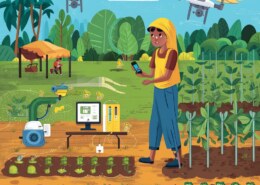Indian food offers a wide variety of flavors and dishes that are influenced by the geography and agriculture of the region. Examine.
Benefits of Using Drones and IoT Devices in Modern Agriculture: 1. Precision Farming: Drones and IoT devices enable precise monitoring of crops, helping farmers apply water, fertilizers, and pesticides exactly where needed, reducing waste and costs. 2. Real-Time Monitoring: They provide real-time daRead more
Benefits of Using Drones and IoT Devices in Modern Agriculture:
1. Precision Farming: Drones and IoT devices enable precise monitoring of crops, helping farmers apply water, fertilizers, and pesticides exactly where needed, reducing waste and costs.
2. Real-Time Monitoring: They provide real-time data on crop health, soil conditions, and weather, allowing for timely interventions and better decision-making.
3. Increased Efficiency: Automating tasks like planting, monitoring, and spraying increases efficiency and saves labor.
4. Higher Yields: By optimizing resource use and monitoring crop health, these technologies can boost crop yields and quality.
5. Reduced Environmental Impact: Precision application reduces chemical runoff and conserves water, benefiting the environment.
Challenges of Using Drones and IoT Devices in Modern Agriculture:
1. High Costs: Initial investment and maintenance costs for drones and IoT devices can be high, making them less accessible for small farmers.
2. Technical Skills: Farmers need technical knowledge and training to operate and maintain these technologies effectively.
3. Data Management: Handling and analyzing the large amounts of data generated can be overwhelming without proper systems in place.
4. Connectivity Issues: Reliable internet connectivity is essential for IoT devices to function properly, which can be a challenge in remote or rural areas.
5. Regulatory Hurdles: Drones are subject to strict regulations, which can limit their use and require compliance with legal requirements.
See less

Indian cuisine is deeply influenced by the country's diverse geography and agriculture, resulting in a wide array of flavors and dishes. Geographical Influence: Northern India: The cooler climate and fertile plains favor wheat cultivation, leading to popular dishes like naan and paratha. Rich, creamRead more
Indian cuisine is deeply influenced by the country’s diverse geography and agriculture, resulting in a wide array of flavors and dishes.
Geographical Influence:
Agricultural Influence:
Overall, India’s cuisine reflects its rich agricultural diversity and regional climatic conditions.
See less